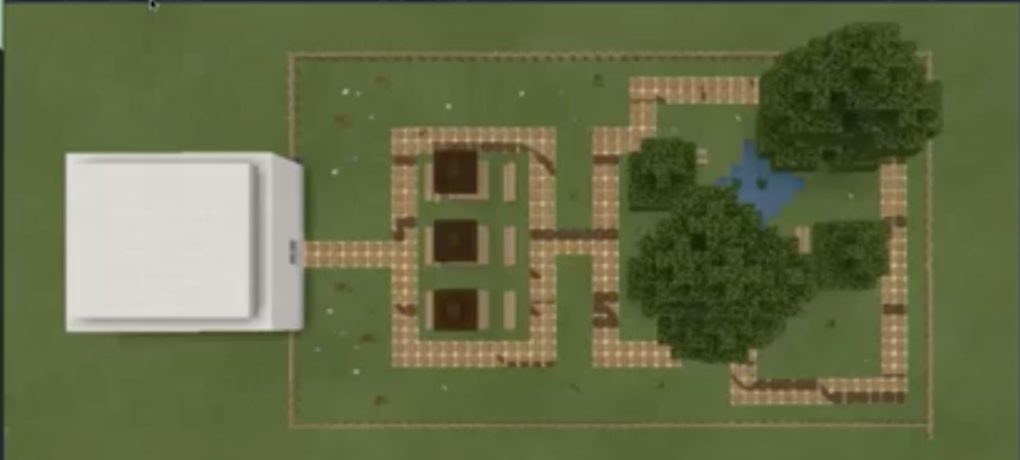
Addressing the Problem
In the last week of the Global Leadership Youth Program Summer 2021, we decided to take a slightly different approach. This module saw students engage with design thinking to work through the following question:
How might we provide equitable, engaging learning opportunities for students worldwide during a global pandemic to reduce learning loss and growing inequities?
Finding a Solution
Throughout the week, students learned how to work towards a solution through an innovative lens. The six groups of students each came up with their own prototype, to be shared as a pitch at the end of the week. To increase the stakes even further, we invited a class of 6th graders from Chula Vista Elementary School District Virtual Academy to judge which prototype deserved (hypothetical) funding. The students’ ideas were so innovative, that we wanted to share them!
Team No Distractions
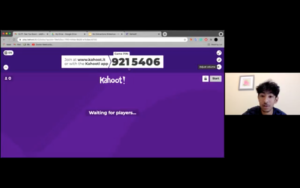
Team No Distractions invented an app called the Anti-Distraction Lesson Plan. The aim of this app was to raise focus levels among students and eliminate in-class distractions which are so pervasive in an online setting. The Anti-Distraction Lesson Plan app would allow students to leave anonymous feedback for teachers, better enabling teachers to gauge student comprehension and attention. The app would also promote the importance of break times, and taking time to refocus. Team No Distractions utilized Kahoots, a quiz-style website, to demonstrate how a similar platform may be used to keep students engaged.
The 18 Group
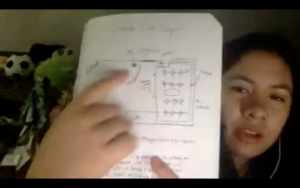
The 18 Group took a different route, focusing on how to engage underserved students with resources typical of remote learning experiences. These include a mobile device, internet services, and a quiet environment for classes. The 18 Group came up with an idea for an internet cafe, where students would receive free access to the internet and a suitable learning environment with the purchase of any item from the cafe. Ultimately, this group chose an internet cafe model as it was the most cost-effective way to serve low-income students with the necessary resources. The 18 Group shared a detailed floorplan of their cafe to demonstrate the functionality of the space.
Blue Pizzas
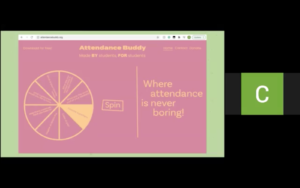
The third group, named Blue Pizzas, designed a website called ‘Attendance Buddy’, whose purpose is to ensure students are able to receive a robust and engaging educational experience, despite being in a virtual setting. The team members created a mock-up of the Attendance Buddy website, including its main feature, a large spinning wheel featuring different questions. These questions are not designed to be difficult, but rather to engage students in discussion, and ready them for a day of work. Blue Pizzas shared that the spinning wheel on Attendance Buddy could also prove useful throughout the class, if students need a short break or time to refocus, through questions such as ‘waffles or pancakes?’.
Team JAM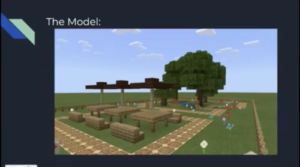
Team JAM designed. an outdoor space which they titled ‘Botanical Library’. The concept behind this idea was to enable students to complete their online classes in an outdoor environment, situated behind a preexisting library. Team JAM provided many reasons why they chose this solution, including that there are many distractions in a home environment and the Botanical Library provides a space for students to work uninterrupted, that it is incredibly beneficial for students to enjoy plenty of fresh air and be immersed in nature, that an outside setting means that students in class would not need to be concerned about disturbing other library patrons inside the building and that safety precautions are much easier to maintain in an outdoor setting. To demonstrate how this would work, Team JAM created a mock-up of the Botanical Library using Minecraft, which provided a detailed visual overview of the concept.
Pandemic Pros
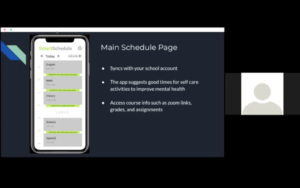
The fifth team, Pandemic Pros, created an app called ‘Smart Schedule’. Pandemic Pros pursued this solution in an attempt to ensure that in hybrid educational settings, virtual students received the same level of attention and support as in-person students. The Smart Schedule app is able to sync classes, recommend self-care practices to students, and set reminders to do important things like stretch, have a snack, drink more water, and take regular breaks. The app also features an optional setting for students to lock their phones while in class, to limit distractions.
T.I.G. 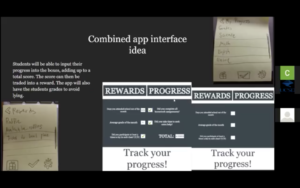
T.I.G., the sixth team, also created an app, albeit a vastly different one. T.I.G.’s app is designed to foster engagement between teachers and students with support from a reward system. The reward system considers multiple factors, including high grades, the input of effort, and engagement in class, leading to tangible prizes for students, like gift cards. T.I.G. suggests that the app would be fully funded, enabling all schools to implement the system for free.
Conclusion
All groups presented incredible ideas (especially considering they had a mere week to work on this!). However, there was only enough ‘funding’ for one group to turn their idea into reality. After a carefully considered vote from our 6th-grade viewers, and a separate discussion among GLYP students, all parties reached a unanimous decision. Team JAM with their Botanical Library pitch were the winners!
The Design Thinking module of GLYP was unlike any previous module we had run, but the students most definitely made the most of this new and exciting format. We are incredibly excited to see how students continue to engage with Design Thinking and utilize the process and their newfound skills for years to come.



Leave a Reply